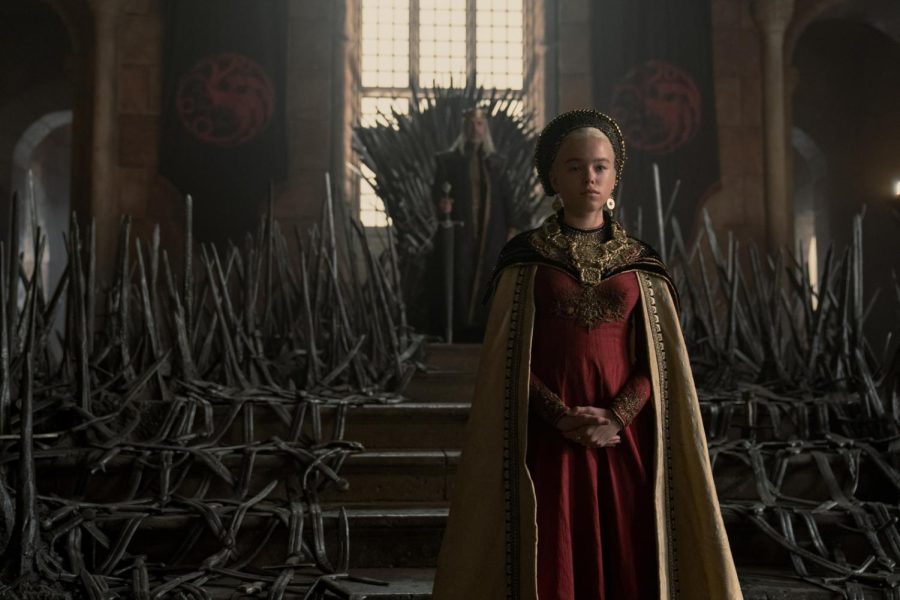Review: ‘House of the Dragon’ avenges iconic characters with new stories
Milly Alcock, Paddy Considine in “House of the Dragon.” Photograph by Ollie Upton. © and ᵀᴹ 2022. Warner Media, LLC. All Rights Reserved.
November 21, 2022
The finale of the first season of HBO Max’s “House of the Dragon,” the prequel to the “Game of Thrones” series, was released Oct. 23, wrapping up a 10-episode season and leaving fans excited for what’s to come.
It has been a long three years since the not-so-fan-favorite end to “Game of Thrones,” which ran for eight seasons from 2011 to 2019 and introduced TV to the medieval world of George R. R. Martin’s “A Song of Ice and Fire” novels. The show is known for its gore, sex, twincest and questionably sane characters — not to mention an ending where the irrelevant Brandon Stark is crowned king while the beloved, fierce Daenerys Targaryen goes off the deep end.
“House of the Dragon” takes place 200 years before “Game of Thrones” and follows the reign of House Targaryen before its fall with King Aerys II Targaryen, or the “Mad King.” The show is nostalgic, with familiar shots of King’s Landing and Dragonstone, the ancestors of prominent houses in “Game of Thrones” making occasional appearances and (thankfully) the same iconic theme song.
With four time jumps ranging from six months to 10 years, the first season covers a lot of ground to set the stage for a family feud which ignites the Targaryen civil war, otherwise known as the Dance of the Dragons. The feud begins with King Viserys III Targaryen, who, due to his inability to have a son with his first wife, makes the contentious decision to name his only daughter, Rhaenyra Targaryen, heiress to the Iron Throne. When Viserys remarries to Alicent Hightower and she bears a son, Aegon, a rift in the family forms and uncertainty spreads throughout the kingdom over who should actually succeed Viserys — as it is tradition for family lines to succeed through men.
A large critique of the “Game of Thrones” series was its unwarranted use of scenes that degraded women, particularly through graphic rape scenes. “House of the Dragon” is not only more sensitive to its viewers, but it dedicates a central portion of its plot to a woman’s multidimensional struggle with power. The female leads — Alicent and Rhaenyra — are both trying to navigate their roles as female royalty. The 20-year time span of the season and recasting of their characters throughout the years allows viewers to witness both their physical and emotional maturity develop as they begin to face the realities of their patriarchal society.
Rhaenyra (Milly Alcock and Emma D’Arcy) is stubborn from the pilot — being named heiress at only 14 years old gives her a new sense of entitlement beyond being a princess. She is rebellious in her youth and unwilling to be confined by societal standards. Notably, she seeks pleasure from sex, a pioneering attitude in a culture that views women as vessels for potential heirs. Rhaenyra pursues who she desires and even arranges for her marriage — made for purely political purposes — to be open. This decision leads to rumors of her sons’ legitimacy, and yet she stands by her family and clings to her father’s support.
Alicent (Emily Carey and Olivia Cooke) is the opposite of Rhaenyra: she lives for her duty as a wife and a mother and tries to stay within the lines of propriety. However, as tensions escalate within her family, Alicent becomes more and more unable to wrangle her emotions, especially toward Rhaenyra, who she resents for being able to evade her social expectations without consequence. A violent outburst at Rhaenyra in one episode reveals a darker, trapped side to Alicent’s character, who, for much of the beginning of the season, seems little more than polite and kind. After the conclusion of this first season, which leaves Alicent disillusioned with the men in her life, viewers can anticipate how Alicent’s character will continue to evolve.
The show also does an excellent job of depicting the agony of childbirth and the physical exhaustion of motherhood. “House of the Dragon” shows Alicent taking care of her crying babies in the middle of the night all alone when she is only a teenager. In a scene that is both raw and terrifying, Rhaenyra pulls her stillborn baby out of her womb after going into premature labor, only moments after hearing the news of her father’s death. Her husband Daemon is notably absent during this grim scene — off somewhere rashly making decisions for a war.
Of course, it wouldn’t be a “Game of Thrones,” spin-off without a little incest, which manifests through Rhaenyra’s complicated relationship with her uncle Daemon Targaryen. She marries him in her family’s best interest and for her own security, and while audiences may cringe at the pairing, Rhaenyra remains steadfast in her decision — for whatever it’s worth.
“House of the Dragon ” has met and exceeded expectations following a predecessor that left much to be desired. Although protagonists Rhaenyra and Alicent have their differences, they evolve into easy-to-root-for characters — not to mention the likeability of actors D’Arcy and Cooke, who have already gone viral on TikTok and popularized the Campari and sweet vermouth cocktail, a negroni sbagliato (with prosecco in it, of course).
Rhaenyra and Alicent’s character evolution in just one season — and their actors’ charming debuts in the franchise — is enough to leave fans eagerly awaiting all that might occur as their rivalry continues as the Targaryen dynasty crumbles and dragons cease to exist.


















